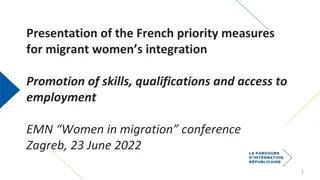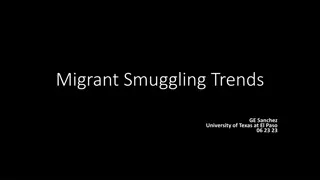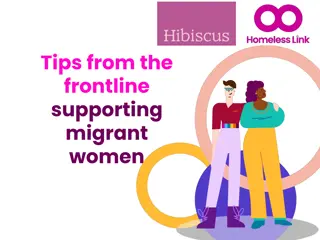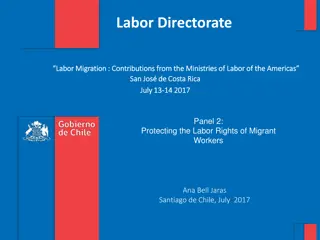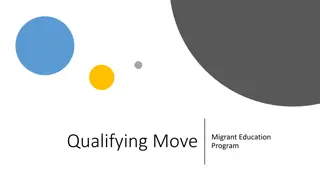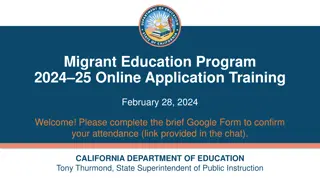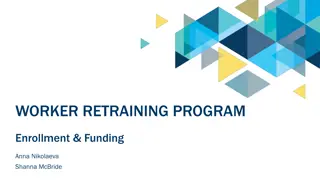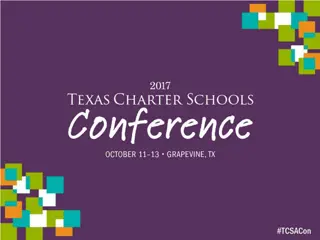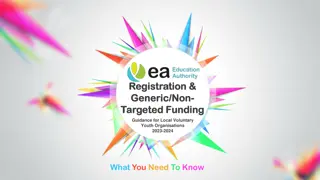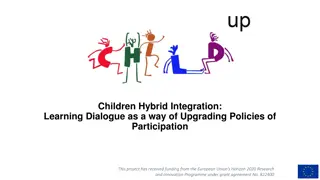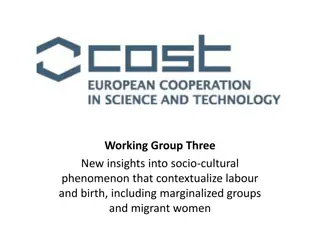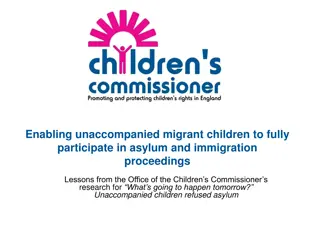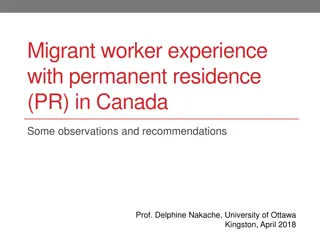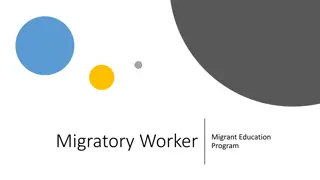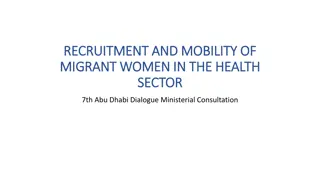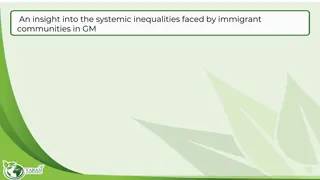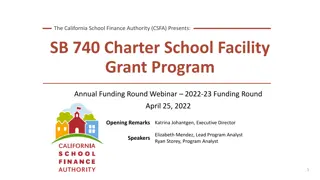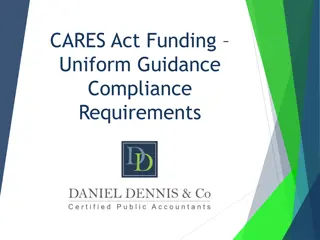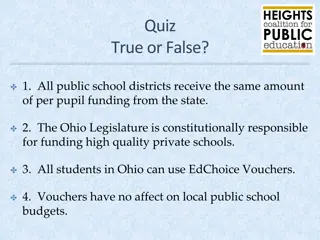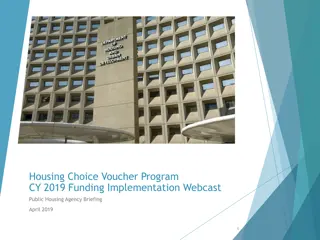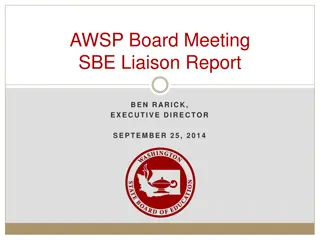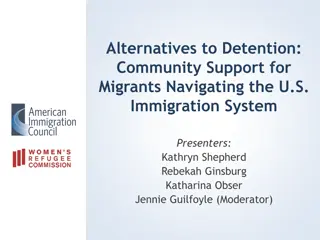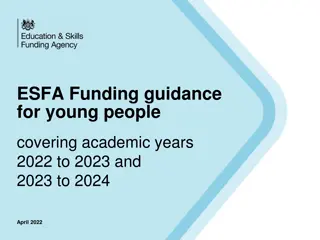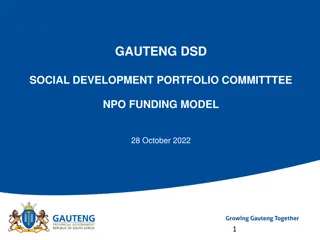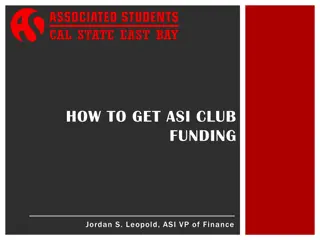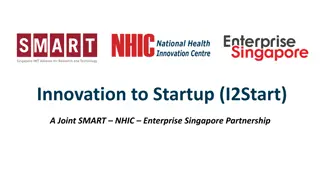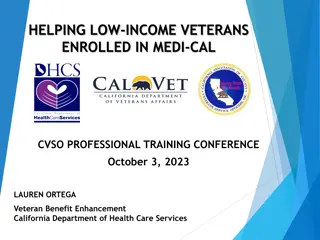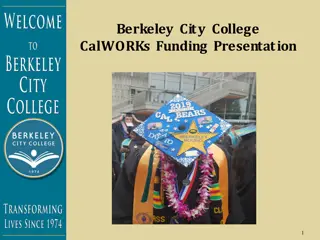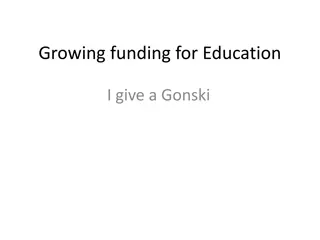Understanding State Migrant Education Program Funding
This module provides new state directors with essential information on the allocation and utilization of funds in the State Migrant Education Program (MEP). It covers legislative guidance, fund allocation for administration and services, allowable activities, evaluation of recordkeeping practices, and action planning based on state needs assessments and service delivery plans. The tutorial offers a structured approach to understanding MEP funding to enhance program effectiveness.
Download Presentation

Please find below an Image/Link to download the presentation.
The content on the website is provided AS IS for your information and personal use only. It may not be sold, licensed, or shared on other websites without obtaining consent from the author. Download presentation by click this link. If you encounter any issues during the download, it is possible that the publisher has removed the file from their server.
E N D
Presentation Transcript
Module 3: State Migrant Education Program Funding Allocation and Use of Funds New Directors Orientation Tutorial
Table of Contents Section Section Slide # Slide # Getting Started 3 Overview of Migrant Education Program Funding 9 Allocation of Migrant Education Program Funds 16 Funding Cycle 20 Use of Funds for State Migrant Education Program Administration Use of State Migrant Education Program Funds for Service Delivery Recordkeeping 32 43 60 Wrapping Up 66 2
Getting Started In This Section In This Section Tutorial Objectives How to Use the Tutorial Icons to Guide You Key Readings and Resources 3
Tutorial Objectives Module 3 will enable new state directors to 1. understand the legislation and regulatory guidance for allocation of Migrant Education Program (MEP) funds to states; 2. determine the amount of MEP funds that can be used for program administration, services, and other allowable activities; 3. understand what types of activities are and are not allowable; 4. understand provision of services; 5. evaluate state education agency (SEA) recordkeeping practices; and 6. create an action plan for reviewing how expenditures align with needs and services identified in your state Comprehensive Needs Assessment (CNA) and Service Delivery Plan (SDP). 4
How to Use the Tutorial For optimal benefit from the tutorial, you should allow sufficient time to read the slides, reflect on the information, and complete all activities on the slides or on the Quick Resource and Reflection Sheets (QRRS) that can be downloaded as worksheets; read each slide as well as the information referenced in the slides; engage with the What Do You Think? slides to facilitate interaction with the information (Answers will be provided directly following each of these slides.); 5
How to Use the Tutorial For optimal benefit from the tutorial, you should (continued) pause to reflect on your state program at the Check-in slides (A QRRS document will typically accompany these.); complete the Pop Quiz! slides to reinforce key concepts; review your state s MEP documents and reports as directed; develop an action plan using the worksheets provided; add actionable items to your MEP planning calendar (See QRRS 14.2.); and contact your OME Program Officer for follow-up questions. 6
Icons to Guide You The following icons will guide you in making the best use of this tutorial: What Do You Think? Check-in Pop Quiz! Quick Reference and Reflection Sheet (QRRS) Action Planning Calendar Item 7
Key Readings and Resources You should have these documents readily available while completing the module, as the module will refer to these documents for more complete information on various topics. MEP Guidance on the Education of Migratory Children under Title I, Part C of the Elementary and Secondary Education Act of 1965, o Chapter I: State Application and Funding o Chapter X: Fiscal Requirements o Chapter XI: State Administration A copy of your state s Consolidated State Application, including any amendments to MEP sections A copy of your state s Service Delivery Plan (SDP) A copy of your last federal monitoring report 8
Overview of Migrant Education Program Funding In This Section In This Section Purpose of the Migrant Education Program Authorizing Legislation Statute, Regulations, and Guidance Guiding Cost Principles 9
Purpose of the Migrant Education Program Assist states to: Support high-quality and comprehensive educational programs for migratory children to help reduce the educational disruptions and other problems that result from repeated moves; Ensure that migratory children who move among the states are not penalized in any manner by disparities among the states in curriculum, graduation requirements, and state academic content and student academic achievement standards; Ensure that migratory children are provided with appropriate educational services (including supportive services) that address their special needs in a coordinated and efficient manner; Section 1301 of the ESEA, as amended 10
Purpose of the Migrant Education Program Ensure that migratory children receive full and appropriate opportunities to meet the same challenging State academic content and student academic achievement standards that all children are expected to meet; Design programs to help migratory children in overcome educational disruption, cultural and language barriers, social isolation, various health-related problems, and other factors that inhibit the ability of such children to do well in school, and to prepare such children to make a successful transition to postsecondary education or employment; and Ensure that migratory children benefit from state and local systemic reforms. Section 1301 of the ESEA, as amended 11
Authorizing Legislation Title I, Part C, Section 1302 of the Elementary and Secondary Education Act, as amended (ESEA), authorizes grants to states to establish or improve, directly or through local operating agencies, establish or improve, directly or through local operating agencies, programs of education for migratory children. programs of education for migratory children. to SEAs have flexibility in the way awarded funds are used. However, any use of MEP funds must adhere to all applicable statute and regulations. Section 1302 of the ESEA, as amended 12
Statute and Regulations State Allocations State Allocations (Section 1303 of the ESEA) SEA Reservation of Program Funds For General Administration SEA Use of Program Funds SEA Use of Program Funds for Unique State for Unique State- -level MEP Administrative Administrative Functions Functions level MEP GEPA 421; 34 CFR Parts 76 & 80 (EDGAR); & 2 CFR Part 200 (Sections 1004 and 9201 of the ESEA; 34 CFR 200.100(b) & 299.4) (34 CFR 200.82) Use of Program Funds for Service Use of Program Funds for Service Delivery by the SEA and/or LOAs Delivery by the SEA and/or LOAs (Section 1304(b)(5) and Section 1306 of the ESEA) 13
Guiding Cost Principles Costs associated with MEP funds must meet the following general criteria: Be necessary and reasonable for performance of the award, and allocable to the program, Conform to any limitations or exclusions set forth in the Office of Management and Budget (OMB) Cost Principles or in the federal award, as to types or amount of cost items, Be consistent with policies and procedures that apply uniformly to federally- financed and non-federally-financed activities of the entity, 14
Guiding Cost Principles Costs associated with MEP funds must meet the following general criteria (continued): Be accorded consistent treatment (costs are treated as either indirect or direct when used for the same purpose in like circumstances), Be determined in accordance with generally accepted accounting principles (GAAP), Not included as a cost or used to meet cost sharing or matching requirements of any other federally-financed program, and Be adequately documented. 2 CFR Part 200 15
Allocation of Migrant Education Program Funds In This Section In This Section State Base Allocation Adjustments to the Base Allocation 16
State Base Allocation MEP funds are allocated to SEAs on a formula basis. By law, the amount of MEP funds that each State receives starts with a base which is the amount of MEP funds that the SEA received for FY 2002. The base amount is based upon: base allocation, A calculation of the state s full-time equivalent (FTE) count of eligible migrant children (using Category 1 and Category 2 Child Counts data) for the 2000-2001 reporting period, and The state s per-pupil expenditures (SPPE) 17
Adjustments to the State Base Allocation The availability of federal funds less the Department of Education (ED) set aside amount for coordination activities (Section 1308 of the ESEA, as amended). If Congress appropriates MEP funds for any fiscal year in an amount that is less than the total amount all SEAs received in FY 2002, each state s base amount is ratably reduced. If Congress appropriates MEP funds for any fiscal year in an amount that exceed the amount appropriated for FY 2002, the states receive the base amount and an additional amount based on their current counts of migrant children and the their current SPPE amount. (To date, Congress has never appropriated an amount of MEP funds that exceeds the amount appropriated for FY 2002) 18
Check-in How much was your state MEP allocation this fiscal year? How were allocated funds used to provide educational services to migrant children in your state? See QRRS 3.1- State MEP Funding Review 19
Funding Cycle In This Section Consolidated State Application Process Funding Availability Period Funding Cycle Closeout State Funding Cycle 20
SEA Application for Funding SEAs may apply for Title I, Part C funds by submitting to ED either: o A Title I, Part C (MEP) program-specific application or o A Consolidated State Application. All States receiving MEP funds have chosen to submit consolidated State applications that included Title I, Part C. Applications are submitted at the beginning of each reauthorization cycle and remain in effect, subject to the need to provide amendments based on change of facts or circumstances, until the effective date of the next ESEA reauthorization. 21
Consolidated State Application Your state accountability office will have the most current Consolidated State Application and any amendments submitted for ED review and approval. o If you cannot locate a copy within your SEA, please contact your OME Program Officer. 22
Amendments to Consolidated State Application If the SEA makes a substantive change to the Consolidated State Application, the SEA is required to obtain ED s approval of the proposed amendment. OME recommends that you contact your program officer to discuss changes prior to submitting a formal amendment to ED. Contacting your program officer in advance will: o Provide you with a sounding board to talk through reasons for making changes and how those changes will affect the state delivery of services to migrant children and o Increase the chance that an amendment submitted to ED will be approved upon initial submission. 23
Check-in Before contacting your MEP program officer, you will want to do some preliminary planning. See QRRS 3.2 Revising Your State MEP 24
Funding Availability Period ED awards MEP funds to SEAs for a 15-month period, beginning on July 1st of the award cycle. While initial funding to SEAs is for a 15-month period, If funds are not obligated may carry over carry over unobligated funds for an additional 12 months, giving the SEA up to 27 months to obligate the funds. obligated by the end of that 15-month period, states o Funds not obligated through a closeout process. Unobligated funds will revert to the federal government and must be returned within 90 days of the end of the 27-month period. obligated by the end of the 27-month period will go EDGAR 76.137, GEPA Sec. 421(b) S25
Funding Availability Period Obligations Obligationsare the amounts of orders placed, contracts and subgrants awarded, services, and similar transactions during a given period that will require payment by the grantee during the same or a future period. SEAs have an additional 90 days beyond the 27-month period to draw down down funds necessary to satisfy payment of funds already obligated within the 27-month period. draw EDGAR 80.23 26
Funding Availability Period There is no special process for requesting a carryover of funds at the end of the initial 15-month period for obligation. Carryover funds must be used in accordance with the statute and regulations that are in effect for the carryover period not the legislation or regulations in effect during the year for which the funds were appropriated (if different legislation or regulations were then in effect). Funds subgranted to a LOA and not obligated by the end of the federal fiscal year (September 30) are considered part of the SEA carryover. A subgrant award is not itself an obligation of any MEP funds. 27
Funding Cycle Closeout If LOAs request a large percentage of MEP funds for carryover from one year to another, this could indicate a significant deficiency in the LOA s planning for and use of MEP funds. A review of LOA expenditures as part of monitoring and reporting is one way to keep abreast of program spending. SEAs have the discretion to: o Allow LOA(s) to carryover unused MEP funds at the end of the initial funding period (for a total obligation period of up to 27 months) or o Take back any previously awarded MEP funds that LOAs do not use in the 12-month initial project period. 28
State Funding Cycle July 1st, Year 1 Grant awarded Sept 30th, Year 2 End of Initial Obligation Period Oct 1st, Year 2 Beginning of Carryover Period Sept 30th, Year 3 End of Carryover Period/Begin Closeout Process Nov, Year 3 Notice of Expiration of Grant Dec 30th, Year 3 Closeout of Grant Period 29
Check-in Are planned state and LOA MEP services and expenditures on target to be completed by the end of the current funding cycle? If not, How will state carryover funds be used? How will LOA s carryover funds be handled by the SEA? 31
Use of Funds for State Migrant Education Program Administration In This Section In This Section Examples of Allowable General Administration Activities State General Administration Spending Limits State Use of Funds for the Administration of Unique Migrant Education Program Activities 32
Examples of Allowable SEA General Administration Activities Some examples of allowable general administrative activities include: Designing and distributing forms required to operate the program (e.g., project applications, performance and financial reports, and evaluation reports); Processing of project applications (subgranting process); Monitoring of projects for fiscal compliance; Maintaining fiscal control and accounting procedures; Disseminating program information; and Developing state MEP rules, regulations, or policies MEP Guidance, Chapter XI 33
SEA General Administration Spending Limits An SEA may reserve for general administrative activities necessary to carry out the MEP, no more than the greater of: One percent (1%) from each of the amounts allocated to the state under ESEA, Title I, Parts A, C, and D or $400,000 ($50,000 in the case of outlying areas). EXCEPTION - If the sum of the amounts allocated to all states for general administration under Title I, parts A, C, and D is equal to or greater than $14,000,000,000, no State s the reservation may exceed 1 percent of the amount the State would receive if $14,000,000,000 were allocated among all of the States for parts A, C, and D. Section 1004 of the ESEA 34 CFR 200.100 34
SEA General Administration Spending Limits SEAs may combine the reserved amounts into a general Title I account for administration of any or all Title I, parts A, C, and D programs. Alternatively, SEAs that receive more than 50% of the resources available for their overall administration from non-federal sources may consolidate administrative funds available under Title I, Parts A, C, and D and many other ESEA formula grant programs into a common administrative pool that may be used flexibly to benefit any or all of the programs that contribute to the pool. Either way, the SEA may always maintain MEP funds available for general administration in a separate accounts and administer the MEP with these funds. 35
SEA Use of Funds for the Administration of Unique Migrant Education Program Activities The SEA may use MEP funds at the State level to pay administrative costs of unique MEP activities, including those functions that are the same or similar to the administrative activities performed by LEAs under the Title I, Part A program. There is no statutory or regulatory limit on the amount of funds that can be used for the administration of unique MEP activities; however, they must be clearly identified as such and not be used for general administration of the state MEP. 36
SEA Use of Funds for the Administration of Unique Migrant Education Program Activities Some examples of unique MEP administrative activities, include: Conducting statewide identification and recruitment (ID&R) of eligible migratory children, including re-interviewing; Coordinating interstate and intrastate state MEP and local projects with other relevant programs and local projects; Establishing procedures for the timely transfer of educational and health records, beyond that required generally by state and local agencies; Collecting and using information for accurate distribution of subgrant funds; 34 CFR 200.82 37
SEA Use of Funds for the Administration of Unique Migrant Education Program Activities Developing a statewide Comprehensive Needs Assessment (CNA) and Service Delivery Plan (SDP); Supervising instructional and support staff; Establishing and implementing a State Migrant Parent Advisory Council (PAC); and Conducting an evaluation of the effectiveness of the state MEP. 34 CFR 200.82 38
Pop Quiz! Instructions: Check the appropriate column to indicate the type of administrative cost under which the activity might be allowable. State MEP State MEP General General Admin Admin Admin of Admin of Unique MEP Unique MEP Activities Activities Activity Activity 1. Conducting migrant parent survey activities concerning migrant children s access to healthcare 2. Convening planning meetings with key stakeholders to develop the state SDP 3. Synthesizing data (e.g., migrant child counts, parent surveys, LOA evaluations) to include in state and federal reports 4. Training for recruiters on interviewing migrant workers concerning the status of children not in schools 5. Responding to federal monitoring reports 39
Pop Quiz! - Response Instructions: Check the appropriate column to indicate the type of administrative cost under which the activity might be allowable. State MEP State MEP General General Admin Admin Admin of Admin of Unique MEP Unique MEP Activities Activities Activity Activity 1. Conducting migrant parent survey activities concerning migrant children s access to healthcare 2. Convening planning meetings with key stakeholders to develop the state SDP 3. Synthesizing data (e.g., migrant child counts, parent surveys, LOA evaluations) to include in state and federal reports 4. Training for recruiters on interviewing migrant workers concerning the status of children not in schools 5. Responding to federal monitoring reports 40
Pop Quiz! - Response Items 3 and 5 pertain to activities required for the general administration of the state-wide MEP. 3. Synthesizing data (e.g., Child Counts, parent surveys, LOA evaluations) to include in state and federal reports MEP data collection and synthesis for state and federal reports 5. Responding to federal monitoring reports monitoring (both state monitoring by federal MEP and LOA monitoring by state MEP are allowable general administration activities) 41
Pop Quiz! - Response Items 1, 2, and 4 are considered unique activities to the MEP, and funds can be used for the administration of these activities. 1. Conducting migrant parent survey activities concerning migrant children s access to healthcare 2. Convening planning meetings with key stakeholders to develop the state SDP 4. Training for recruiters on interviewing migrant workers concerning the status of children not in schools 42
Use of Migrant Education Program Funds for Delivery of Services In This Section In This Section State Use of Funds Provision of Services Special Migrant Populations Recordkeeping Exceptions to Recordkeeping Requirements 43
State Use of Funds SEAs have considerable flexibility in determining how MEP funds are used, as long as they have developed a Statewide plan to ensure: The special needs of migratory children are specifically addressed (ascertained through the Comprehensive Needs Assessment); The plan is developed in collaboration with parents of migratory children; Funds are first used to meet the unique needs of migrant children that result from their migrant lifestyle, and to permit these children to participate effectively in school; 44
State Use of Funds Funds are not used for services migratory children are already eligible for under other programs; Migratory children are given the same opportunity to meet the state academic content standards and student academic standards that all children are expected to meet; Services for migratory children are integrated with other services; Services to be provided are based on a plan that specifies measurable program goals and outcomes; and Services to be provided result from joint planning among local, state, and federal programs, including programs under Title I, Part A, early childhood programs, language instruction educational programs. Section 1306(a)(1) of the ESEA, as amended 45
State Use of Funds In developing an annual budget and determining if expenses are allowable, consider whether the expenses: Provide for services that address the educational needs of migrant children as identified in the CNA and included in the SDP; and Provide for services that are not available from other federal, state, or local programs. 46
Provision of Services For the purposes of the MEP, services that the MEP provides through its program and projects. services are a subset of all the activities Services Services are distinct in that they are the educational or educationally related activities provided to migrant children to enable them to succeed in school. Sections 1304(c)(6) and 1306(b) of the ESEA, as amended Sections 9101(37) and 9501 of the ESEA 47
Provision of Services MEP services are educational or educationally-related activities that: Directly benefit a migrant child; Address a need of a migrant child consistent with the SEA s CNA and SDP; Are grounded in scientifically based research, or in the case of support services, are generally accepted practice; and Are designed to enable the program to meet its measurable outcomes and contribute to the achievement of the state s performance targets. 48
Provision of Services Services can generally be broken down into two types: 1. Instructional services include: o Educational activities for preschool-age children and o Academic instruction for elementary and secondary students 2. Educationally-related support services include: o Advocacy for migrant children; o Health, nutrition, and social services; o Necessary educational supplies; and o Transportation. 49
Pop Quiz! Which of the following is not an MEP service? 1. A school provides literacy tutoring to migrant children at home. 2. An LOA provides health and nutrition classes to migrant families with school-age children. 3. A school establishes a half-day educational program for pre-K migrant children. 4. An LOA conducts activities to identify and recruit migrant children for enrollment in public schools. 50


